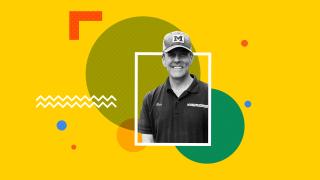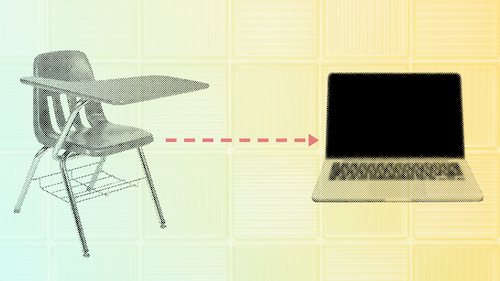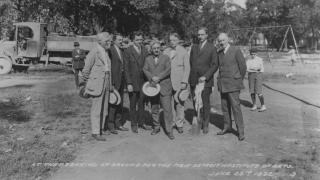
Throughout the month, we’ve been bringing you stories about how the campus is reacting to the coronavirus pandemic, and you may have noticed, we haven’t yet given you a glimpse of how faculty are coping. That was, in fact, intentional. Given how quickly our professors had to transition, we wanted to give them a couple weeks to find their stride before hitting them up to share their triumphs and struggles. However, in the brief gap between the end of classes and the start of finals, we hit up three faculty to get their thoughts. Associate Professor Lisa Martin, Lecturer Grace Helms Kotre and Assistant Professor Amy Brainer all had interesting things to say about their teaching. But they had another message: Being a “good” professor to your students in this moment goes way beyond academics. Here’s our discussion, which has been condensed and edited lightly for clarity.
The Reporter: So I guess let’s start with the obvious: How has the switch to remote classes been going?
Lisa Martin: I’m teaching two classes this semester; one was online before this situation and those students haven't really missed a beat. My in-person, once-a-week, three-hour Monday night class was the challenge. It’s a high-level class, where the groups facilitate a lot of the discussion and the readings, and really, a senior seminar should never be an online experience. In addition to that, it’s a class with a lot of Health and Human Services students, and many of them work, in some capacity, in hospitals. So they're all being asked to work overtime, some of them were quarantined, and a couple of them are in home situations that are not the best for them to live and learn.
For me, the focus became much less about content very quickly and much more about their ability to engage safely and make some sense of all this. Since we couldn’t have in-person discussions, I made online discussions that were focused on the content of the class. But I also gave them assignments to do journal entries that weren’t content related, so that if nothing else, I could check in on them. Nobody else sees those journals, and they’ve been blunt about what’s dark in their lives, what’s good in their lives, what they’re learning about themselves in this crisis. And the completion rate for the journals is much higher than the completion rate for the discussions.
The Reporter: And what does that tell you?
Lisa: That they want someone checking on them. It’s the isolation that they’re struggling with the most, and they’re repeatedly telling me, for instance, that they’re trying to do the final paper, but their brains just aren’t focusing. I think we have to be sympathetic to that. Given that they’re public health- and gender-oriented students, there’s a lot in this current crisis that’s about health, gender and reproduction. So instead of the regular assigned readings, I’m telling them to figure out what’s going on in the world that’s relevant to our class. That’s where their heads are. So they’re still doing the critical thinking, but the content is a little different.
The Reporter: And Grace and Amy, how’s it been going for you?
Grace Helms Kotre: Well, like Lisa, I’ve been adapting the content to what’s going on all around them. One of the classes I’m teaching is actually about stress management, so there are many direct connections. The challenge for me is that my courses are highly interactive, so suddenly not being able to see my students was psychologically overwhelming for me at first. Right now, I’m recording all my lectures, which is interesting, because I never just lecture for an hour and then get their feedback at the end. I’m also recording them in my “home office” — my daughter's room with stuffed animals and butterflies and flowers all over the wall — by myself, talking to myself, which is hilarious.
I’m also offering live office hours, but almost no one comes. Like Lisa, I’ve heard from many students who are feeling isolated, aren’t feeling motivated, are working 12-hour days in a hospital, or who are struggling with their home situations. So I get why they’re not coming to these optional check-ins with me. But then there’s no face-to-face time, and I really worry about my students who seem to have just fallen off the face of the Earth. I’m also lengthening the guided meditations that I’ve been doing at the start of classes. The majority of students have said that’s really helpful. I feel almost like the main point of my communication with them needs to be self-care.
Amy Brainer: I resonate with what Lisa and Grace have said. When we moved online, I created two syllabi for each of my three courses. In the first syllabus, I tried to approximate the in-class content and flow in an online format. In the second, I pared down the course to only key assignments. I let students pick the one that made sense for them given their circumstances, no questions asked. I haven't been counting, but I'd say it's about 50-50. Some people feel comforted by business as usual, while others genuinely need a reprieve.
The Reporter: Inside the higher education community, there’s a lot of discussion around whether students are getting the same quality of education with this switch to online. But I think I’m hearing you push back a bit about the framing of that issue.
Lisa: The reality is you’re not teaching an online course; you’re teaching during a pandemic. You’re all experiencing a trauma and it doesn’t have to be perfect. Like, this class that I moved online, I would never revise it and teach it as an online class under normal circumstances. We’re doing this because it’s an emergency. There are several other courses that, if I knew we had to teach online for the next year, I would teach those instead because they’re more adaptable and I know the students could thrive.
What helps me is to simplify. It’s not keeping it simple to erase the complexity, it’s about taking away anything that’s unneeded. Like, I don’t have a late policy right now, because that’s something I can let go of. Assignments still have a due date, but I use that to follow up with you if you miss a due date. A penalty is not an important learning tool right now. Having structure with flexibility is what’s important. The other thing I would add is that I don’t equate quality with rigidity. And I don’t even equate quality with content knowledge. For right now, quality is recognizing humanity, practicing empathy — and we can still do critical thinking. If those are the three things they get out of this experience from having interactions with me, I’m convinced they ‘got their money’s worth’ or have had a good experience.
Grace: I agree completely. I think we’re often “doing”-oriented in our culture, and when we’re hit with a challenge like this, we want to try to fix it or make it better. But one of the interesting lessons from this crisis is that if you’re not a health care or essential worker, the way you make it better is to stay home. But being at home, by yourself, can be extremely uncomfortable. And it’s not necessarily “stay home, stay safe” if you’re a student dealing with severe depression. I think students look to us as mentors or as people who can offer guidance and support. And right now, they're needing that more than anything. I mean, I’ll have students reply to my check-in emails, just thanking me for reaching out, because no one was doing that for them. That shows you what the priorities have to be right now.
Amy: Yes to all of this. Going online shines a spotlight on the inequities that already exist among our students. Home situations, access to the internet, economic precarity — all of these are factors in the learning experience. I have students who are themselves very sick with the virus. I have students who are caring for sick loved ones and who have lost people close to them. They are grieving alone. I am experiencing this, too, as the pandemic touches my social circle. I think it's important for me to model self-compassion and let students know that it's OK to do less.
I’ve actually had some energizing moments as an instructor during this period, especially teleconferences with students about their projects. For half an hour, an hour, we lose ourselves in ideas, in learning. It’s such a good feeling. Then we reemerge into this difficult environment. We ask after loved ones, wish each other good health and hang up the call. There’s something life affirming about the ability to use our imaginations and to grow intellectually, while also being together as people in this experience.
The Reporter: Finally, many people are already beginning to think about how this pandemic may have lasting impacts on our institutions. Does anything about your experience thus far hint at how higher education might be fundamentally changed by this?
Lisa: I don't know that we know yet. When we go through something that’s difficult, we often want to rush to process it so we can feel like we’re on the other side of it. So I don’t have expectations yet about that kind of impact, other than it will have an impact. But I am jotting down my thoughts now, so that in a year, I’ll have a record of that and can understand it better. I’m thinking about things like the ability of students to engage with their emotions and connect their mental health to being good students. I see potential in that — even in classes where that’s not the focus. Can that happen in a chem lab? Can that happen in a political science course? I’m already seeing a lot of colleagues who were very content-focused and maybe more rigid starting to open up.
Grace: The other thing, for me, is that this crisis has helped me pay more attention to what is most important as an instructor. When I’m grading papers, for example, is it really important that I’m nitpicking about citation formats? I mean, I can still make a note of that, but am I going to take off a ton of points? This is something we talk about in the context of supporting students from international backgrounds or ESL students or students who’ve not had educational experiences that have built them up as writers. So what’s really important? Is it that they have perfect APA citations? Or is it that they got the point?
Amy: I think education is strongest and most useful when we don't ask students to compartmentalize their lives, but welcome them in their wholeness. I hope that academia moves in this direction. In addition, as a social scientist, I hope that we continue to fight hard against the deep cleavages in our society that make this pandemic deadlier for black people; for people who are incarcerated in detention centers, prisons, and jails; and for people with asthma, diabetes, and other conditions that we know are exacerbated by poverty. As a queer person, I inherited from my elders the AIDS pandemic slogan “silence equals death.” Our silence about these issues is not an option.
Lisa: I don’t want to end the interview without saying that I’ve talked with lots of colleagues at other institutions, and I’ve been really happy with how our institution has provided resources but tried not to overwhelm. The library staff, in particular, has stepped up in ways nobody saw coming. I mean, who thought, ‘Here’s a global pandemic — librarians, you are the first line of support for the entire campus!’ But they have been. For example, there was a movie I was going to show in class that we didn’t have the streaming rights for. And three different librarians got me access to two alternatives that we did have rights to, and then ultimately came through with rights to the movie I wanted to show in the first place. They did it quickly and efficiently, and I didn’t have to worry about it. So those types of supports have been so key in helping us to make this shift — and they didn’t have more lead time than the rest of us.





